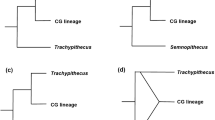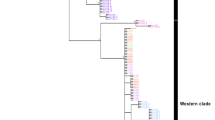Abstract
Golden langurs (Trachypithecus geei) are an endangered primate species in Bhutan. We discuss their evolution in terms of phylogeny, ecology, and biogeography. We test the hypothesis that rivers and mountains in Bhutan isolated a population of capped langurs (Trachypithecus pileatus) that later speciated into the morphologically distinct T. geei. Trachypithecus, the genus to which both capped and golden langurs belong, spread north from a paleorefuge in south China, and Semnopithecus (gray langurs) spread east and northward from a refuge in south India. We show that the 2 genera both arrived in Bhutan and were separated from each other by the Sunkosh River and Black Mountains. Likewise, a population of capped langurs isolated from parental populations by rivers speciated into the distinct golden langurs. We conducted field surveys covering the entire range of langurs in Bhutan. The Sunkosh River and Black Mountain range in west Bhutan isolate gray langurs and golden langurs from each other. In the east, the Manas River system (Manas-Mangde) served as a barrier between golden and capped langurs. However, it is an imperfect barrier and a contact zone between the 2 species occurred on the banks of the Mangde River. Second, we reconstructed the evolutionary history of the langurs of Bhutan via molecular phylogenetic tools. We sequenced the cytochrome b region (cyt b) of the mitochondrial DNA (mtDNA) to model a phylogeny. It revealed the distinct evolutionary paths of the golden, capped, and gray langurs. As predicted, golden and capped langurs are closely related to each other and to other species in Trachypithecus from Southeast Asia. The gray langur of Bhutan grouped into a distinct clade with conspecifics in Semnopithecus from India and Nepal. The south Indian clade of gray langurs is more ancient, with the Bhutan and Nepal gray langurs having diverged later, which fits with the glacial models of ice sheet retreats and colonization of South Asia by gray langurs from south India north toward the Himalayas. Likewise, the golden and capped langur clade are the most derived and divergent from the older groups of Trachypithecus in Southeast Asia, which also fits with paleorefuge models of recolonization by Trachypithecus into the rest of Southeast Asia and north toward the Himalayas from paleorefuges in Southeast Asia. As predicted, golden and capped langurs are closely related to each other and gray langurs are only distantly related to them. The divergence between capped and golden langurs is more recent, while the split between Trachypithecus and Semnopithecus is more ancient and took place before the Pliocene.






Similar content being viewed by others
References
Baker, L., Nadler, T., & Geissmann, T. (2000). Viet Nam: Primate field guide. Fauna & Flora International, Indochina Programme, Hanoi. (p. 8). (English and Vietnamese text).
Brandon-Jones, D. (1996). The Asian Colobinae (Mammalia: Cercopithecidae) as indicators of Quaternary climatic change. Biological Journal of the Linnean Society, 59, 327–350.
Brandon-Jones, D. (2004). A taxonomic revision of the langurs and leaf monkeys (Primates: Colobinae) of South Asia. Zoos’ Print J., 19, 1552–1594.
Brown, W., George, M., & Wilson, A. C. (1979). Rapid evolution of animal mitochondrial DNA. Proceedings of the National Academy of Sciences of the United States of America, 76, 1967–1971.
Corbet, G., & Hill, J. (1992). The mammals of the indomalayan region: A systematic review. Oxford: Oxford University Press.
Ellerman, J., & Morrison-Scott, T. (1966). Checklist of Palaearctic and Indian Mammals 1758 to 1946 (p. 810). London: British Museum (Natural History).
Finn, F. (2002). Sterndale’s mammalia of India (p. 347). New Delhi: Cosmo.
Gee, E. P. (1961). The distribution and feeding habits of the golden langur, Presbytis geei Gee (Khajuria, 1956). Journal of the Bombay Natural History Society, 58, 1–12.
Geissmann, T., Groves, C., & Roos, C. (2004). The Tenasserim Lutung, Trachypithecus barbei (Blyth, 1847) (Primates: Cercopithecidae): Description of a live specimen, and a reassessment of phylogenetic affinities, taxonomic history, and distribution. Contributions to Zoology, 73, 271–282.
Groves, C. (2001). Primate Taxonomy. Washington, DC: Smithsonian Institution Press.
Hrdy, S. (1977). The langurs of Abu: Female and male strategies of reproduction. Cambridge, MA: Harvard University Press.
Karanth, P. (2000). Molecular systematics and phylogeography of the langurs of asia. Ph.D. dissertation. University at Albany, State University of New York.
Irwin, D. M., Kocher, T. D., & Wilson, A. C. (1991). Evolution of cytochrome b gene in mammals. Journal of Molecular Evolution, 32, 128–144.
Johns, G., & Avise, J. (1998). A comparative summary of genetic distances in the vertebrates from the mitochondrial cytochrome b gene. Molecular Biology and Evolution, 15, 1481–1490.
Myers, N., Mittermeier, R., Mittermeier, C., da Fonseca, G., & Kent, J. (2000). Biodiversity hotspots for conservation priorities. Nature, 403, 853–858.
Oates, J., & Davies, A. (1994). Colobine Monkeys: their ecology, behaviour and evolution. Cambridge: Cambridge Univ. Press.
Olson, D., & Dinerstein, E. (1998). The global 200: A representation approach to conserving the earth’s most biologically valuable ecoregions. Conservation Biology, 12, 502–515.
Pocock, R. (1928). The langurs, or leaf monkeys, of British India. Journal of the Bombay Natural History Society, 32, 472–677.
Posada, D., & Crandall, K. (1998). Modeltest: Testing the model of DNA substitution. Bioinformatics, 14, 817–818.
Roonwal, M., & Mohnot, S. (1977). Primates of South Asia: Ecology, sociobiology, and behavior. Cambridge, MA: Harvard University Press.
Roos, C., Geissmann, T., & Groves, C. (2004). Molecular phylogeny of leaf monkeys. Unpublished direct sequence submission to GenBank. (http://www.ncbi.nlm.nih.gov/entrez/viewer.fcgi?db=nucleotide&val=46410423)
Swofford, D. (2002). PAUP*. Phylogenetic analysis using parsimony (*and other methods). Version 4. Sunderland, MA: Sinauer Associates.
Swofford, D., Olsen, G., Waddell, P., & Hillis, D. (1996). Phylogenetic inference. In D. Hillis, C. Moritz, & B. Mable (Eds.), Molecular Systematics (pp. 407–514). Sunderland, MA: Sinauer Associates.
Thompson, J., Gibson, T., Plewniak, F., Jeanmougin, F., & Higgins, D. (1997). The ClustalX windows interface: flexible strategies for multiple sequence alignment aided by quality analysis tools. Nucleic Acids Research, 25, 4876–4882.
Valdiya, K. (1998). Dynamic Himalaya. Jawaharlal Nehru centre for advanced scientific research. Hyderabad, India: Universities Press.
Wangchuk, T. (1995). A census and biogeography of golden langurs (Presbytis geei) in Bhutan. TigerPaper FAO, UN Bulletin on Wildlife and National Parks Management, 22, 1–6.
Wangchuk, T., Inouye, D., & Hare, M. (2003). A new subspecies of golden langur (Trachypithecus geei) from Bhutan. Folia Primatologica, 74, 104–108.
Wangchuk, T., Kawamto, Y., & Aimi, M. (2001). Discovery of a contact zone between golden langurs (Trachypithecus geei) and capped langurs (Trachypithecus pileatus) in Bhutan. American Journal of Primatology, 54(Supplement 1), 40.
Wangchuk, T., Thinley, P., Tshering, K., Tshering, C., & Yonten, D. (2004). A field guide to the mammals of Bhutan. Thimphu: Royal Government of Bhutan.
Author information
Authors and Affiliations
Corresponding author
Rights and permissions
About this article
Cite this article
Wangchuk, T., Inouye, D.W. & Hare, M.P. The Emergence of an Endangered Species: Evolution and Phylogeny of the Trachypithecus geei of Bhutan. Int J Primatol 29, 565–582 (2008). https://doi.org/10.1007/s10764-008-9258-5
Received:
Accepted:
Published:
Issue Date:
DOI: https://doi.org/10.1007/s10764-008-9258-5




